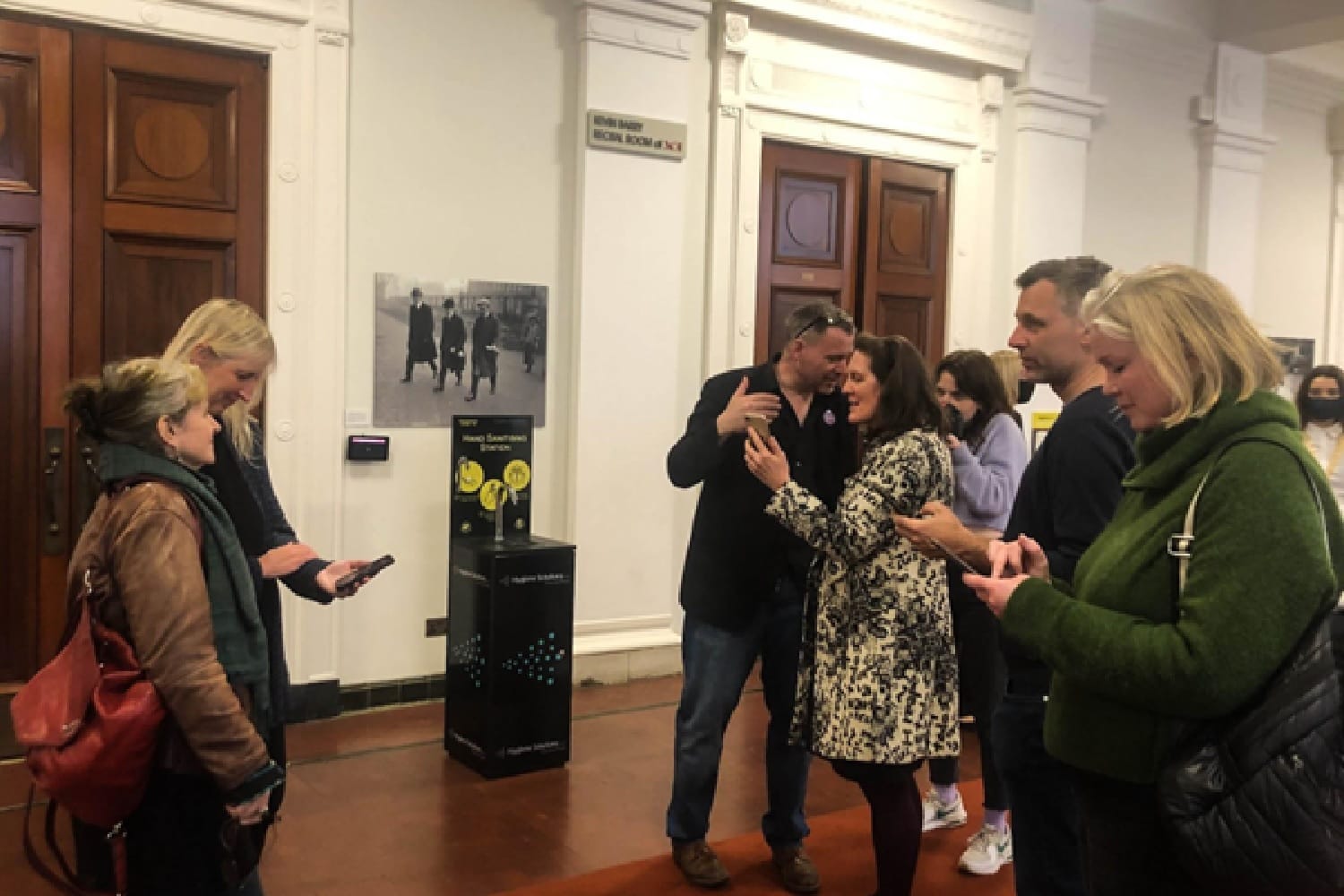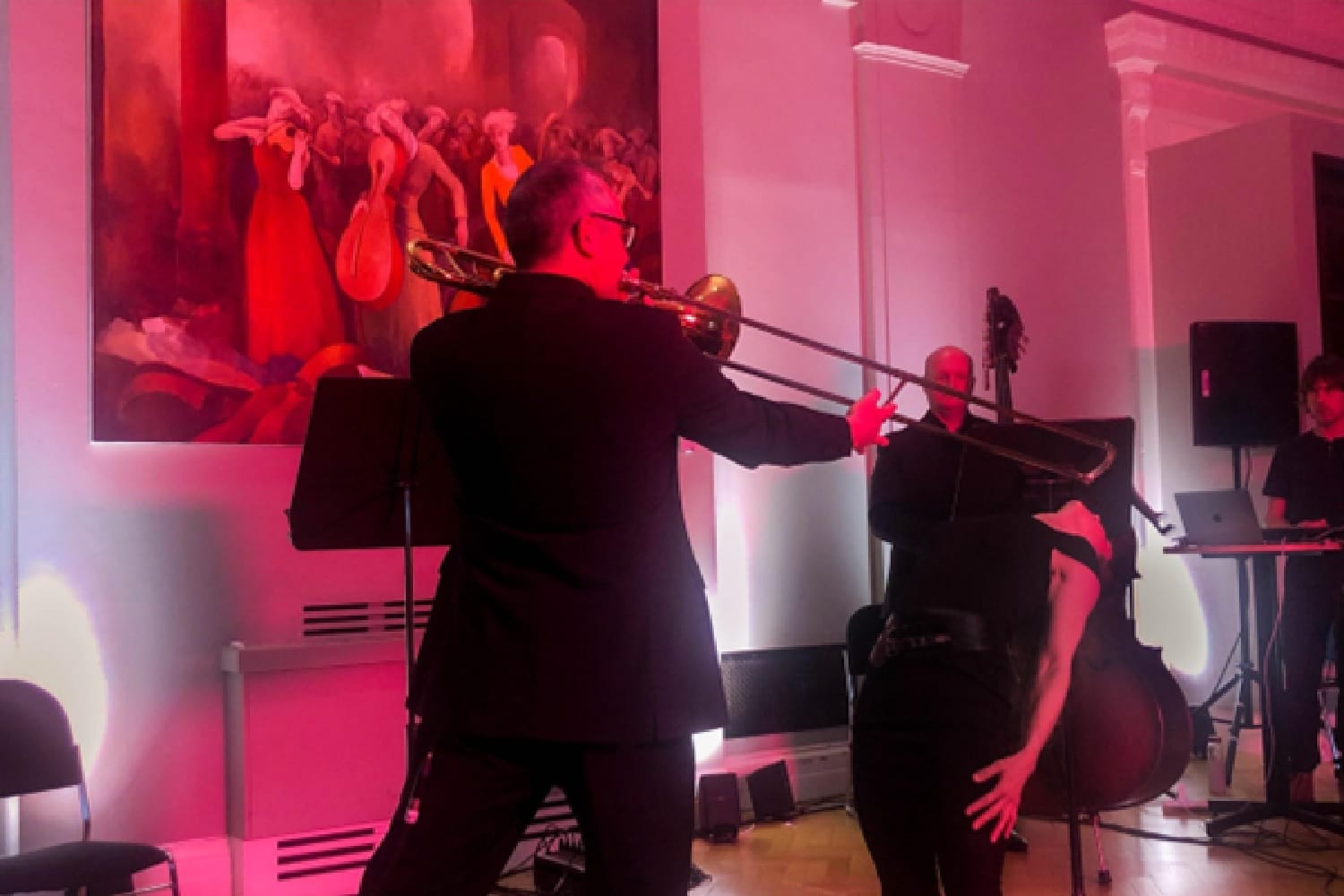What’s the best way to tell area residents about plans for a new asylum shelter nearby?
The government should tell communities directly about plans for new asylum shelters, some activists and politicians say.
George Higgs’ works are shaped by years of experimentation with multi-sensory approaches to music, which have even led him to create his own instruments.

In the Kevin Barry Recital Room of the National Concert Hall, the audience are just about settled in their seats when the host, Jonathan Grimes, asks everyone to get up again.
“If you could leave your seats, proceed outside, and open up Instagram,” he says.
Attendees to this show at the New Music Dublin festival slowly rise to their feet and move towards the exits, walking past a dancer and five musicians with their instruments at the top of the room.
One of them, composer George Higgs, stands by a synthesiser.
Higgs has just explained that the pieces he and the ensemble are to perform will be streamed live on Instagram, and that the audience can watch it all on their phones from outside the room.
“But don’t go far, because we’re going to play it all again,” he says to some uncertain looking stragglers, assuring them that they can return to the venue for a second rendition.
Everyone is here to see Higgs’ silent poems, which he has written in what he calls a “gestural lyric” based on Irish Sign Language. Dancer Jessica Kennedy will perform the poems as Higgs and the other musicians play the accompaniment.
As a crowd begins to gather in the corridor, Higgs encourages everyone to spread out. The phones may fall out of sync as people listen, he says. “So you might want to wander away from other people, so your sound doesn’t conflict with others.”
Small groups huddle around screens.
The performance begins with the easy, rolling bellow of a trombone leaking out into the corridor from inside the Kevin Barry room, and the sound echoes with slight delays from the scattered speakers of audience members’ phones. “Like a sort of laggy canon,” says one attendee.
They watch on their phones as Kennedy moves through the room, dancing the blend of signing and interpretive movements that make up the poem’s gestural lyric.
Groups chatter quietly about what they see and hear. The live feed has created a sense of intrigue and as the performers come to the end of their set, the audience moves towards the venue, waiting for the doors to be opened for the second performance.

Higgs’ poems are the most recent product of years of experimentation with multi-sensory approaches to music, he says, an area he became interested in through his work with the deaf community.
He worked briefly with the Dublin Deaf Choir in 2010 before taking up a job in St Mary’s School for Deaf Girls in Ashtown.
When he started working in St Mary’s, Higgs had aims.
“One was to learn about the deaf experience of music and the second was to work with extra-auditory means of musical expression and experience,” he says. “Another was building instruments based on the students’ strengths.”
Higgs worked out a way to break down the elements of musical expression in a way that was intuitive for his students.
“The first stage was that we would focus on the action we were executing to make a sound. So we’d all have a stick and we’d hit something with the stick, and focus on hitting together, in unison,” he says.
He next introduced a pattern to the striking, and various materials, to provide different tactile sensations, he says. “You not only see the different material, but also feel how the rebound is different on each one.”
Hearing people experience melody as the difference between one note and the next, while this was a felt melody, he says. “Each strike is a very different experience with your hands.”
As he continued to work with students at St Mary’s, Higgs found that his hopes to learn about the deaf experience of music started to make less sense. “As far as I could tell, it was impossible to pinpoint the deaf experience of music.”
There was no singular experience, he says.
That’s the same for hearing people too, Higgs says. Each of us experiences music differently, bringing our own knowledge, tastes, experiences and cultural conditioning, he says.
And even for someone who is profoundly deaf, there may be some sensations of sound that contribute to the musical experience.
He realised his second aim, to work with extra-auditory expressions, was a problem too, he says. “I realised you couldn’t isolate the senses. You need to think collectively.”
With this in mind, Higgs went on to develop an instrument for his students called The Machine of Song, which had vibro-tactile features and visual feedback elements.
“The instrument was quite insane,” says Jaima Gago, one of Higgs’ former students at St Mary’s. “But it was awesome, because it truly does work wonders.”
“It reflects how I experience sounds daily using different senses, mainly with sight and touch, and that machine has brought it to life, to show others how people like me experience sounds,” says Gago.
“This is quite challenging, to explain to others how we experience it, and I find that machine really brings in a fully immersive experience,” she says.
When he finished at St Mary’s, the idea that the musical experience involved a sensually collaborative process, a concept Higgs came to describe as a sense ensemble, continued to influence his work.
He explored the idea further while studying for a PhD in Trinity College Dublin, and found that it gets to something essential about our experiences of music.
For deaf and hearing people alike, he says, you cannot isolate modalities. “You need to think of senses collectively.”

With the crowd settled back into their seats at the National Concert Hall for the second performance, Higgs and his ensemble showed how the visual sense, too, can be involved in musical experience.
In the intimate confines of the Kevin Barry room, the audience can see up close as trombone player Rossa O’Neill faces Jessica Kennedy, the dancer, to perform the first poem, “Mouse Moves Mountain”.
O’Neill pulls the slide out towards Kennedy’s face. She leans back gracefully, letting it extend into the space over her head, before sticking out her hand in a signed gesture and straightening her posture, forcing O’Neill to pull the slide back in and take a couple of steps back.
Kennedy’s signs and dance movements, and the physical production of sound, all became part of the gesture that visually evoked the sense of the poem.
While dancing inherently evokes this visual side of music, Kennedy is keen to highlight where the overlap with signing begins and ends.
“Of course it’s saying a lot more, but I find sign language very beautiful to watch,” she says. “What I’m interested in is that not only is it a language but it’s a movement language.”
For dancers, this is familiar territory. “We work in a physical language, that’s how we transmit stories. How we speak is through movement,” she says.
Kennedy, who runs the dance company Junk Ensemble with her twin sister Megan, was able to draw on past experiences with sign language for the performance. She received a bursary from the Arts Council a few years ago to learn sign language and to incorporate it into her work.
That the poems are intelligible to a non-signing audience at all points to this shared linguistic space inhabited by both dance and sign language. But in the two coming together, is there a danger of the signs becoming unintelligible for deaf audience members?
“I think they would be intelligible, yeah”, says Kennedy. “But mostly they are abstracted, even just because they’re done whilst moving, which is outside of the traditional signing approach.”
When trying to bring different mediums together, you get an inherently abstracted result, but that doesn’t mean it isn’t intelligible, says Gago, who has gone on to work with Higgs creatively since finishing at St Mary’s, translating instrumental music into sign language.
“I could understand how it was abstract, but if we use one sign, it affects how deaf people perceive it,” she says.
The expressiveness and individuality inherent in language use is something both Gago and Kennedy point to as part of the creative process which lends itself to this kind of abstraction, and Gago says it has precedents in deaf culture.
“It reminds me of visual vernacular,” she says, “a unique form of art used to tell a story through a visual using aesthetic and expressive sign language, gestures and facial expressions.”
When writing the poems, Higgs was determined not to let the process become too formulaic, so he approached each poem differently, he says. “Because you could very quickly get stuck into this slavish mindset of writing a set of gestures, and then finding a rhythm, but that gets boring.”
He decided on short, alliterative, haiku-ish poems, and varied his approach each time, sometimes focusing on the form of the gestures, while for other poems he let the communicative content lead his decisions.
“‘Mouse Moves Mountain’, that was one of the first poems I composed, and I liked the movement, and I liked the sentiment”, he says.
This was how he approached composing the accompaniments, too. “With_ ‘_Letters Lose the Law of Language’, that one was very rhythmical in the set of signs, and I used that for the piece acoustically,” says Higgs. “For all the instruments, I took different parts of the metrical aspect of those lines.”
With the April performance of his poems wrapped up, Higgs is now working on a pandemic-delayed project in Dún Laoghaire, he says.
He has used the knowledge he’s built in vibro-tactile music over the years to buy some new equipment.
He is using that in an educational programme he is designing with Music Generation, an initiative that seeks to break down barriers which prevent children and young people from accessing musical experiences.
Higgs has been keeping up with the latest developments in vibro-tactile equipment, he says, and with the happenings in university acoustics departments in the UK.
Those all excite him, he says. “That’s the next step, and I’m really glad I’m involved in that because I’d love it to get more precise. It’s important.”
Get our latest headlines in one of them, and recommendations for things to do in Dublin in the other.